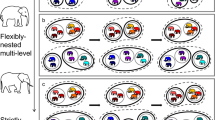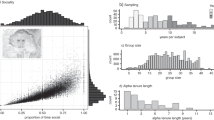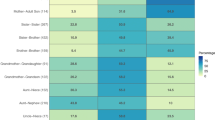Abstract
Some of the most highly social animals-including elephants, and some primates, cetaceans, and social carnivores-live in “fission-fusion” societies where social groups divide and re-form over the course of hours, days, or weeks. These societies are thought to respond adaptively to changes in the physical and social environment, and are thus ideal for testing hypotheses about the evolutionary forces that shape sociality. However, few models have been developed to measure and explain fission-fusion dynamics. Here we isolate several key components of the social behavior of wild African elephants (Loxodonta africana) using a bilinear mixed effects model, proposed by Peter Hoff (J. Am. Stat. Assoc. 100(469):286–295, 2005). The model enables inference on environmental effects, such as rainfall and seasonality, and is flexible enough to include predictors of pairwise affiliation, such as kinship, which allows large-mammal ecologists to test assumptions about elephant social structure and to develop new theories of why and how elephants interact. In addition, this model includes an unobserved latent social space to represent the interactions between elephants not incorporated by the measured covariates.
Similar content being viewed by others
References
Alexander RD (1974) The evolution of social behavior. Annu Rev Ecol Syst 5:324–383
Altmann J (1974) Observational study of behavior: sampling methods. Behaviour 49:227–267
Archie EA, Moss CJ, Alberts SC (2003) Characterization of tetranucleotide microsatellite loci in the African Savannah elephant (Loxodonta africana africana). Mol Ecol Notes 3:244–246
Archie EA, Moss CJ, Alberts SC (2006) The ties that bind: genetic relatedness predicts the fission and fusion of groups in wild African elephants (Loxodonta africana). Proc R Soc Lond 273:513–522
Douglas-Hamilton I (1972) On the ecology and behaviour of the African elephant: the elephants of Manyara. Oxford University Press, Oxford
Dunbar RIM (1992) Time: a hidden constraint on the behavioral ecology of baboons. Behav Ecol Sociobiol 31:35–49
Hoff PD (2005) Bilinear Mixed-Effects Models for Dyadic Data. J Am Stat Assoc 100(469):286–295
Hoff PD, Raftery AE, Handcock MS (2002) Latent Space Approaches to Social Network Analysis. J Am Stat Assoc 97(460):1090–1098
Holland P, Leinhardt S (1981) An exponential family of probability distributions for directed graphs. J Am Stat Assoc 76:33–50
Kummer H (1995) In quest of the sacred baboon. Princeton University Press, Princeton
Lee PC, Moss CJ (1995) Statural growth in known-age African elephants (Loxodonta africana). J Zool 236:29–41
Lusseau D, Newman ME (2004) Identifying the role that animals play in their social networks. Proc R Soc Lond B, Containing papers of a Biological character, 271 Suppl 6, S477–S481
Moss CJ, Poole JH (1983) Relationships and social structure of African elephants. In: Hinde RA (ed) Primate social relationships. Sinauer, Sunderland, pp 315–325
Moss CJ (2001) The demography of an African elephant (Loxodonta africana) population in Amboseli, Kenya. J Zool 255:145–156
Pulliam HR, Caraco T (1984) Living in groups: is there an optimal group size? In: Davies KA (ed) Behavioral ecology, pp 122–147
Queller D, Goodnight K (1989) Estimating relatedness using genetic markers. Evolution 43:258–275
Rubenstein DI (1978) On predation, competition, and the advantages of group living. In: Bateson PPG, Klopfer PH (eds) Perspectives in ecology. Plenum, New York, pp 205–231
Sade D, Dow M (1994) Primate social networks. In: Wasserman S, Galaskiewicz J (eds) Advances in social network analysis: research in the social and behavioral sciences, pp 152–166
Shortreed S, Handcock MS, Hoff PD (2006) Positional estimation within the latent space model for networks. Methodology 2(1):24
Taberlet P, Griffin S, Goossens B, Questiau S, Manceau V, Escaravage N, Waits LP, Bouvet J (1996) Reliable genotyping of samples with very low DNA quantities using PCR. Nucleic Acids Res 24:3189–3194
Wittemyer G, Douglas-Hamilton I, Getz WM (2005) The socioecology of elephants: analysis of the processes creating multitiered social structures. Animal Behav 69:1357–1371
Wrangham RW (1980) An ecological model of female-bonded primate groups. Behaviour 75:262–300
Author information
Authors and Affiliations
Corresponding author
Rights and permissions
About this article
Cite this article
Vance, E.A., Archie, E.A. & Moss, C.J. Social networks in African elephants. Comput Math Organ Theory 15, 273–293 (2009). https://doi.org/10.1007/s10588-008-9045-z
Published:
Issue Date:
DOI: https://doi.org/10.1007/s10588-008-9045-z




